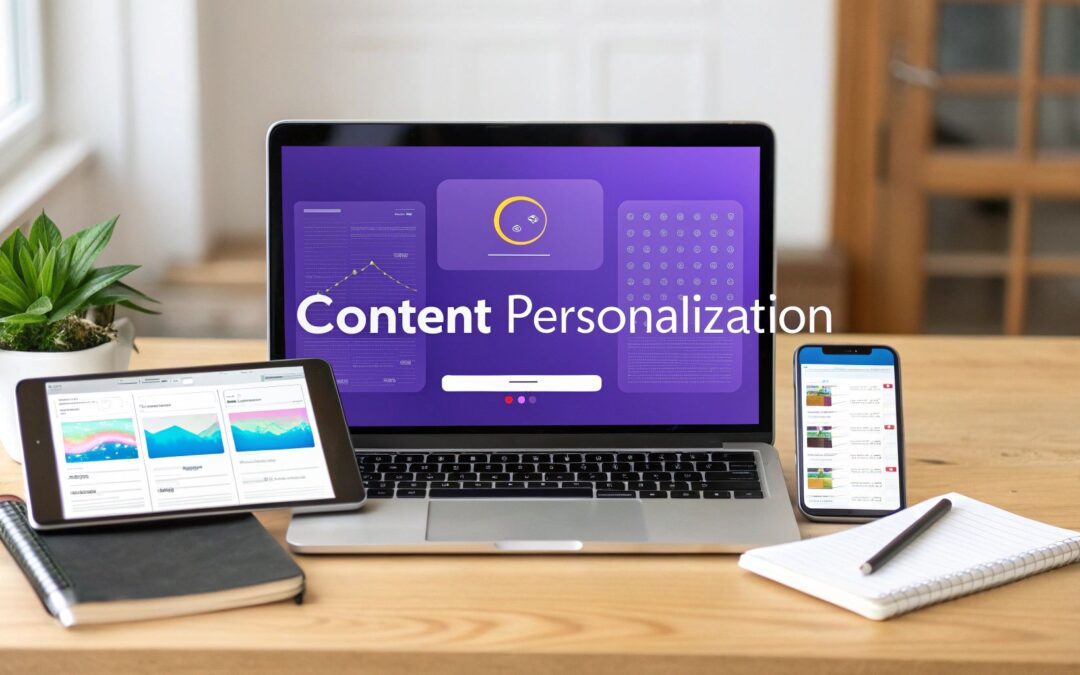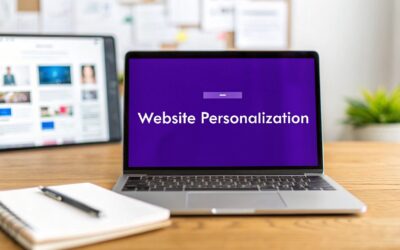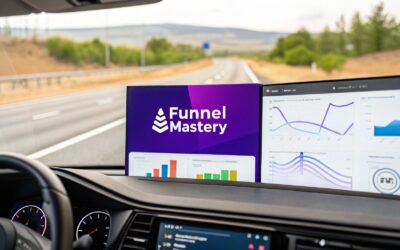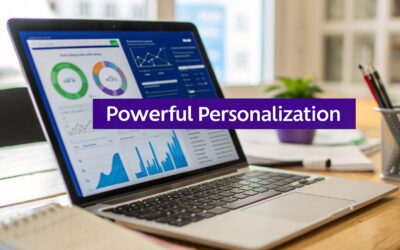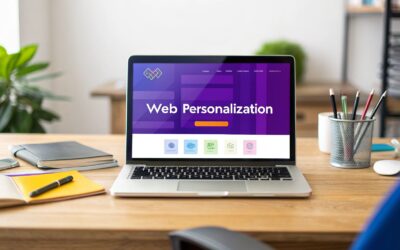Imagine walking into your favorite coffee shop, and the barista starts making your usual—a double-shot latte with oat milk—without you even having to ask. That’s the feeling content personalization aims to create on your website.
Instead of greeting every visitor with the same generic homepage, you’re tailoring the content, offers, and messages to fit them specifically. It’s about knowing what they need before they even have to look for it.
The Shift From Monologue to Dialogue
At its core, personalization transforms your website from a static, one-way billboard into a dynamic, one-on-one conversation. It's the difference between a brand shouting a single message to a massive crowd and whispering a genuinely helpful suggestion to a single person.
This is all made possible by gathering user data—like what pages they’ve visited or what they’ve bought before—and using it to deliver an experience that feels like it was built just for them. You’re moving away from the old "one-size-fits-all" model and acknowledging that every visitor is unique, with their own set of needs and goals.
What Makes It All Work?
So, how does this actually happen? It’s not magic, but a smart combination of data and technology working behind the scenes. Let's break down the main building blocks.
The Building Blocks of Personalization
Here’s a quick look at the essential elements that work together to create a personalized website experience for every visitor.
| Component | What It Does | A Simple Example |
|---|---|---|
| User Data Collection | Gathers information about visitors, like their location, browsing history, or past purchases. | An e-commerce site remembers you bought running shoes last month. |
| Customer Segmentation | Groups users into audiences based on shared traits or behaviors. | The site puts you in a "Running Enthusiasts" segment. |
| Dynamic Content Delivery | Uses rules or algorithms to show the right content to the right segment at the right time. | Next time you visit, the homepage shows you new running gear instead of soccer cleats. |
These components create a simple but powerful feedback loop: data tells you who the user is, segmentation helps you understand what they might want, and dynamic delivery makes it happen.
This diagram helps visualize how these pieces connect to form a cohesive strategy.
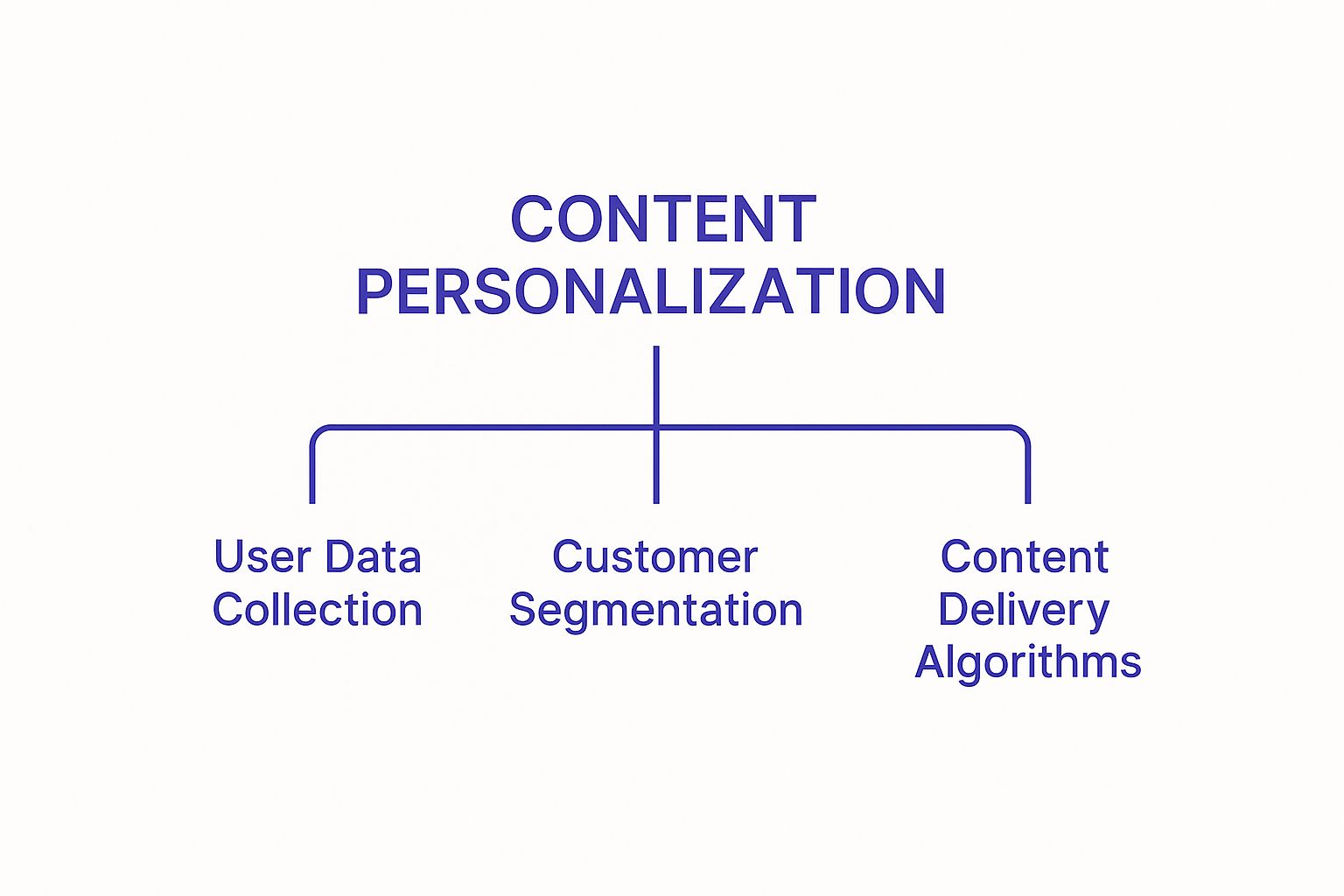
As you can see, personalization isn't a single action. It’s a complete system where data informs segmentation, which in turn dictates the content that gets delivered.
Why It Matters More Than Ever
Let's be honest—the internet is a noisy place. Generic, one-size-fits-all messages are easy to tune out. Personalization cuts through that noise by making your content immediately relevant and valuable to the person seeing it. The data doesn't lie; when an experience feels personal, people are far more likely to engage, convert, and stick around.
A personalized website doesn’t just show people what they want to see; it shows them you understand who they are. This shift from broadcasting to conversing is the key to building stronger customer relationships and driving real business growth.
Ultimately, understanding content personalization is about recognizing its power to make every digital interaction feel more human. It’s about building a smarter, more intuitive experience, one visitor at a time.
Why Generic Content No Longer Works
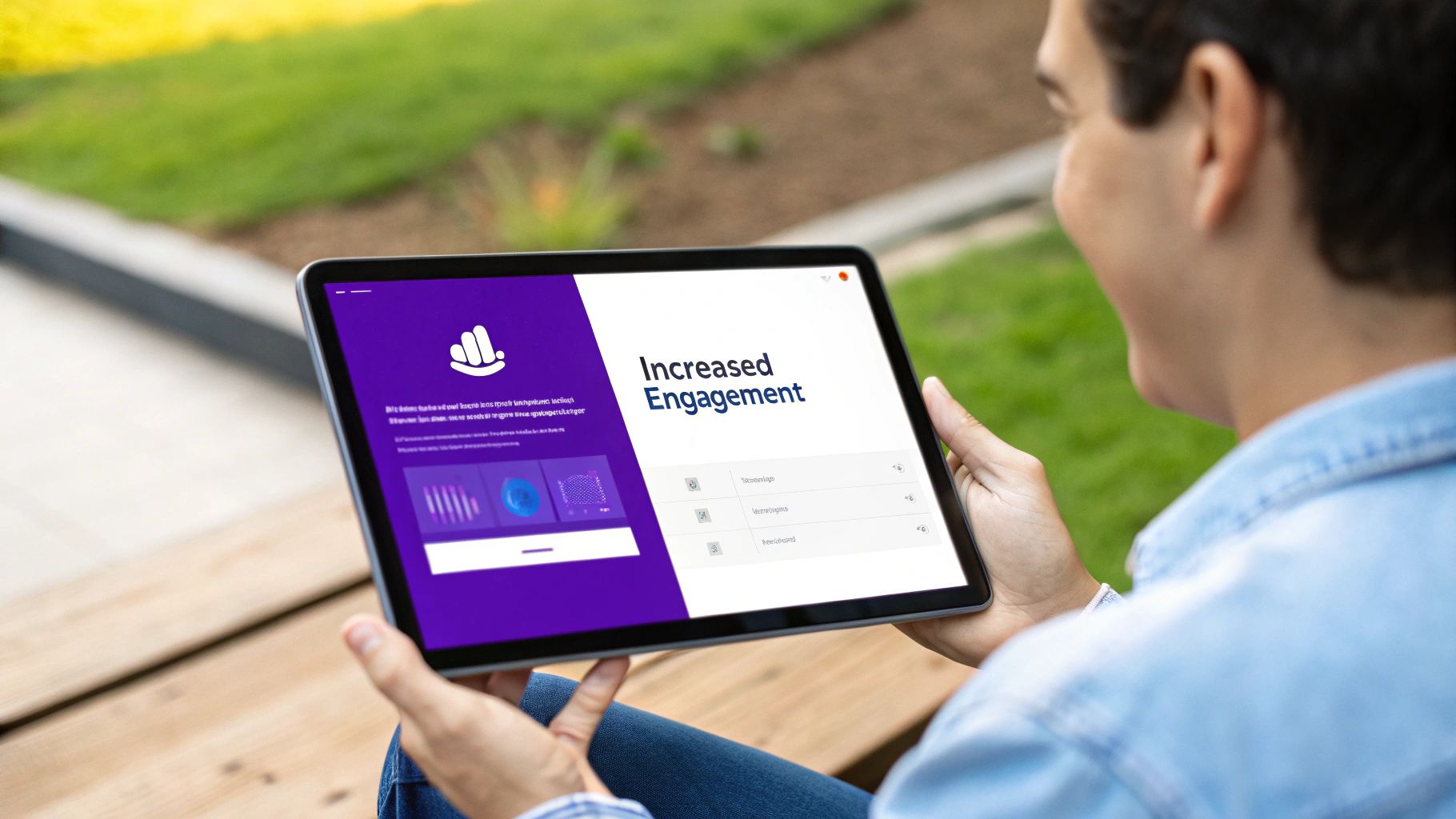
Let’s be honest, the old "one-size-fits-all" approach to content is completely broken. We live in a world overflowing with information, where your audience is bombarded with messages every single second. Attention has become the most valuable currency online.
Generic content is just too easy to ignore. It’s noise. It fails to answer the single most important question every visitor has: "What's in it for me?"
Think about it. When someone lands on your site and sees a vague headline or a generic offer, there's no spark. Nothing connects with their specific problem or what they’re trying to achieve. They feel invisible, and in the blink of an eye, they're gone. This phenomenon is often called "content blindness," and it’s a huge roadblock to growth, leading directly to higher bounce rates and missed opportunities.
The Real Cost of Being Vague
This isn't just a theoretical problem; it has a real, tangible impact on your bottom line. Every person who leaves your site because the message felt irrelevant is a potential sale walking out the door. Over time, that chips away at your marketing ROI and makes it incredibly difficult to stand out.
Showing a B2B software solution to a hobby blogger? That’s a wasted impression. Promoting winter coats to someone living in Florida? It just makes your brand seem out of touch. These little disconnects add up, creating an experience filled with friction.
This is exactly where understanding what is content personalization gives you a massive advantage. It’s about shifting from shouting one message at everyone to having a meaningful conversation with each individual.
Personalization is more than just a buzzword; it's a fundamental shift in communication. It acknowledges that behind every click is a unique person, and the brands that truly get this are the ones that win.
The numbers back this up in a big way. Research shows that 76% of consumers are more likely to buy from brands that personalize, and a staggering 78% are more likely to become repeat customers. The reward is huge—companies that get it right see 40% more revenue from personalization than their slower competitors. To really grasp the impact, you can explore more about these trends and their impact on profitability.
Key Business Drivers for Personalization
Moving away from generic content isn’t just about making people feel good; it’s driven by solid business goals. When you tailor the user journey, you see measurable improvements where it counts.
- Increased Engagement: Relevant content is sticky. Visitors stay longer, click on more pages, and interact with your brand on a much deeper level. This not only builds a stronger connection but also sends great signals to search engines.
- Higher Conversion Rates: A personalized call-to-action is infinitely more powerful than a generic one. When you show the right message to the right person at the right time, you remove the guesswork and make it incredibly easy for them to say "yes."
- Enhanced Customer Loyalty: Personalization makes customers feel seen and valued. This builds trust and turns one-time buyers into loyal fans who come back again and again, and even better, tell their friends about you.
Exploring Different Personalization Strategies
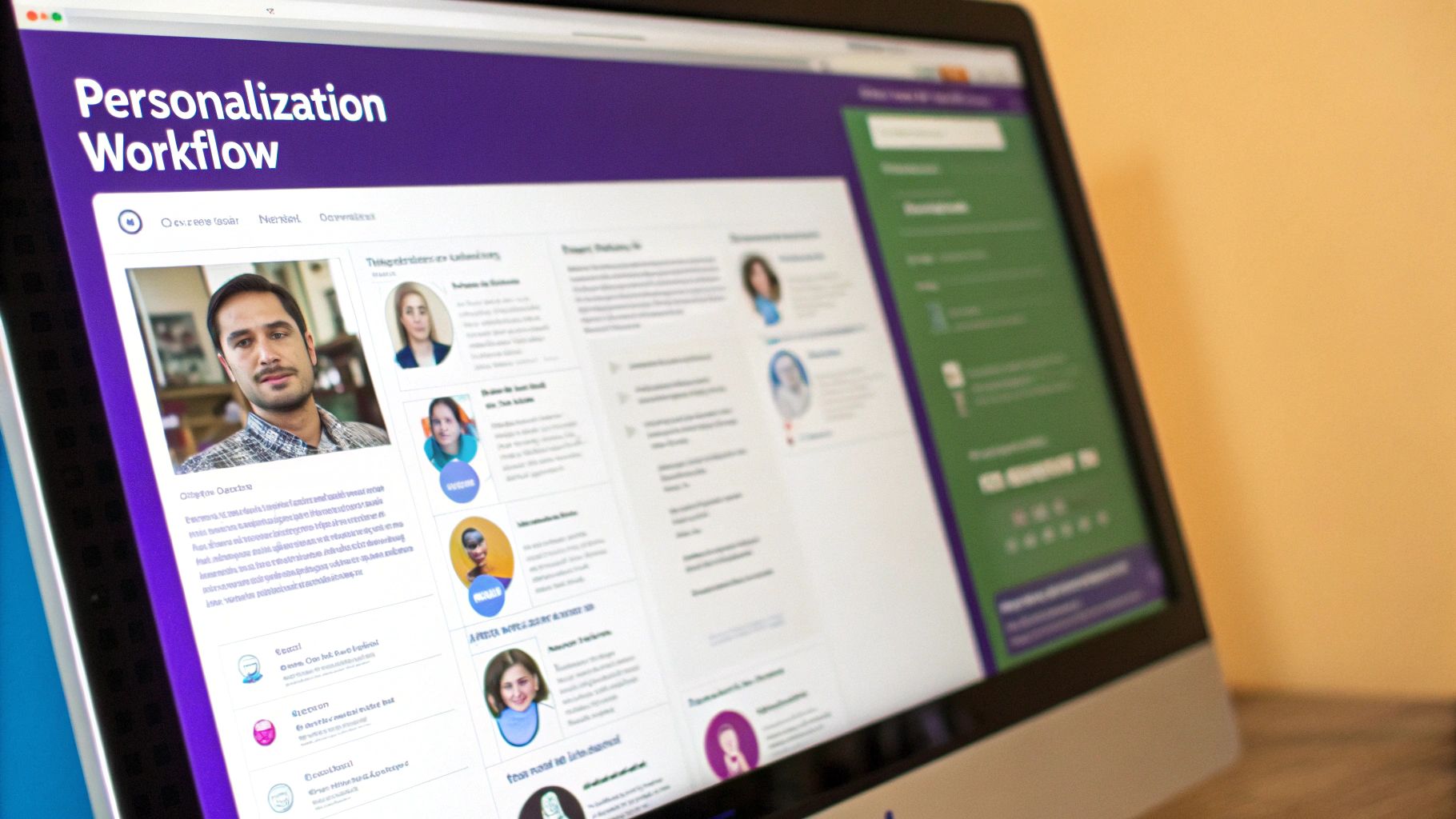
Personalization isn’t a single, one-size-fits-all tactic. It’s a spectrum of different approaches, each using different kinds of data to shape the user experience. These methods can range from simple, broad-stroke adjustments to incredibly specific, individual-level tweaks. Getting a handle on these different strategies is the first step toward building a smarter, more responsive website.
The most straightforward place to start is with demographic personalization. This strategy uses basic, observable information about a visitor to group them into broad categories.
Think of it like a local shop changing its window display for the holidays. It’s a simple adjustment based on a known, general condition, but it still makes the experience feel more relevant.
Leveraging User Context and Demographics
Demographic strategies are effective because they’re built on stable, easily accessible data points. While they aren't as granular as other methods, they provide a solid foundation for making your site feel more relevant right off the bat.
Some common demographic data points you can use are:
- Location: Showing a banner for a local event only to visitors from that specific city.
- Language: Automatically switching the website to Spanish for users who have a Spanish browser setting.
- Device Type: Offering an "Download on the App Store" button exclusively to visitors on an iPhone.
This type of personalization is an excellent starting point. It delivers immediate value without needing to know anything about a user’s past behavior. It's a quick win that makes your site feel more intuitive from the first click.
Building on this is contextual personalization, which uses real-time, situational data to adapt your content. This could mean changing offers based on the time of day, the weather in the visitor's location, or even the marketing channel they came from. For example, a visitor clicking from a Facebook ad about a specific product could land on a page that immediately highlights that exact item.
Adapting to User Behavior in Real-Time
Now for the most powerful approach: behavioral personalization. This is where you adapt the experience based on a user's past and present actions on your site. Here, you’re moving away from broad segments and getting closer to having one-to-one conversations.
This strategy tracks actions like pages visited, articles read, products viewed, or items added to a cart. An e-commerce store might show a "Recently Viewed Items" section to a returning visitor. A blog could recommend articles that are closely related to the ones a user has already finished reading. For a full breakdown of these methods, check out our guide on powerful https://divimode.com/website-personalization-strategies/.
Beyond just on-site content, a truly effective personalization plan often involves strategies like understanding retargeting in marketing to re-engage users after they've left. Ultimately, the real magic happens when you combine these different strategies, creating a deeply layered and effective personalization engine.
How Winning Brands Use Personalization
It's one thing to talk about personalization in theory, but seeing it in action is what really drives the point home. The biggest names in the game—think Netflix and Amazon—have built their entire empires on delivering experiences that feel like they were made just for you.
They've cracked the code on using data to figure out what you want, sometimes even before you do.
Take Netflix, for instance. Its recommendation engine is the stuff of legend. It's so good at suggesting your next binge-watch that it feels like magic, but it’s pure data science. The platform analyzes your viewing history, your ratings, and even the time of day you watch to create a homepage that’s uniquely yours. This is why a staggering 80% of watched content on Netflix comes directly from these recommendations.
Amazon runs on a similar playbook. That "Customers who bought this also bought" feature? It’s a masterclass in personalization that drives a huge chunk of their sales. It turns a simple shopping trip into a guided tour, constantly surfacing products that genuinely match your interests.
It’s Not Just for the Giants
This isn't some secret strategy reserved for billion-dollar B2C companies. The same core ideas work wonders across almost any industry.
- Travel Sites: Imagine a travel site notices you’ve been looking at beaches in Southeast Asia. The next time you visit, it doesn't show you a generic homepage. Instead, it puts deals for flights to Thailand and Vietnam front and center.
- B2B Software: A B2B company can often tell what industry a visitor is from. The website can then instantly adapt its homepage to feature case studies and testimonials from that specific sector, making its value crystal clear from the first click.
- Hospitality: Hotels and booking platforms can completely reshape a customer's journey from start to finish. If you want to see how this translates into real results, check out how top hospitality brands personalize guest experiences with data.
At its heart, personalization is just empathy at scale. It’s about using technology to show your customers you get them, which is the fastest way to build trust and drive action. You can see more powerful website personalization examples in our detailed guide.
This isn't just a trend; it's a fundamental shift in user expectations. The demand for smarter, more adaptive experiences is fueling massive growth. The recommendation engine market alone—the tech that powers these features—is on track to hit $12 billion by 2025. It’s all driven by customers who now expect content that understands their needs and intent.
Bringing Personalization to Your Website
Knowing the theory is one thing, but actually putting personalization into practice is where you'll see the real magic happen. For WordPress and Divi users, this isn't some far-off, complicated goal—it's more reachable than ever before. Tools like Divi Areas Pro are designed to turn those abstract strategies into simple, hands-on rules you can set up in just a few minutes.
The core idea is refreshingly simple. You create a piece of content (what we call an "Area") and then tell it exactly when and for whom it should appear. This is the switch that flips your site from a static, one-size-fits-all page to a dynamic experience that actually responds to each visitor.
Setting the Rules for Your Content
This is where you get to play director. Instead of wrestling with code, you're using simple dropdown menus to define the triggers. You’re essentially telling your website who should see what, and when. It's a hands-on approach that puts you squarely in control of the user's journey.
You can stack different conditions together to create a website that feels incredibly responsive and smart.
- New vs. Returning Visitors: Imagine greeting first-time visitors with a special "Welcome!" discount code. For your regulars? You could show a "Welcome Back!" message that points them straight to your newest blog posts.
- Based on User Role: If you're running a membership site, this is huge. You can display an exclusive offer or an important update that only your logged-in "Premium Members" can see. Everyone else won't even know it's there.
- Targeted by Location: Got a local business? You could create a banner promoting an in-store event that only appears for visitors browsing from your specific city or state.
This is the kind of control that turns a generic website into a genuine marketing powerhouse. By setting up these simple-but-powerful rules, you're making sure every message you send is relevant, timely, and lands in front of the right person.
Here’s a quick look at the Divi Areas Pro interface. You can see just how straightforward it is to start building these conditions.
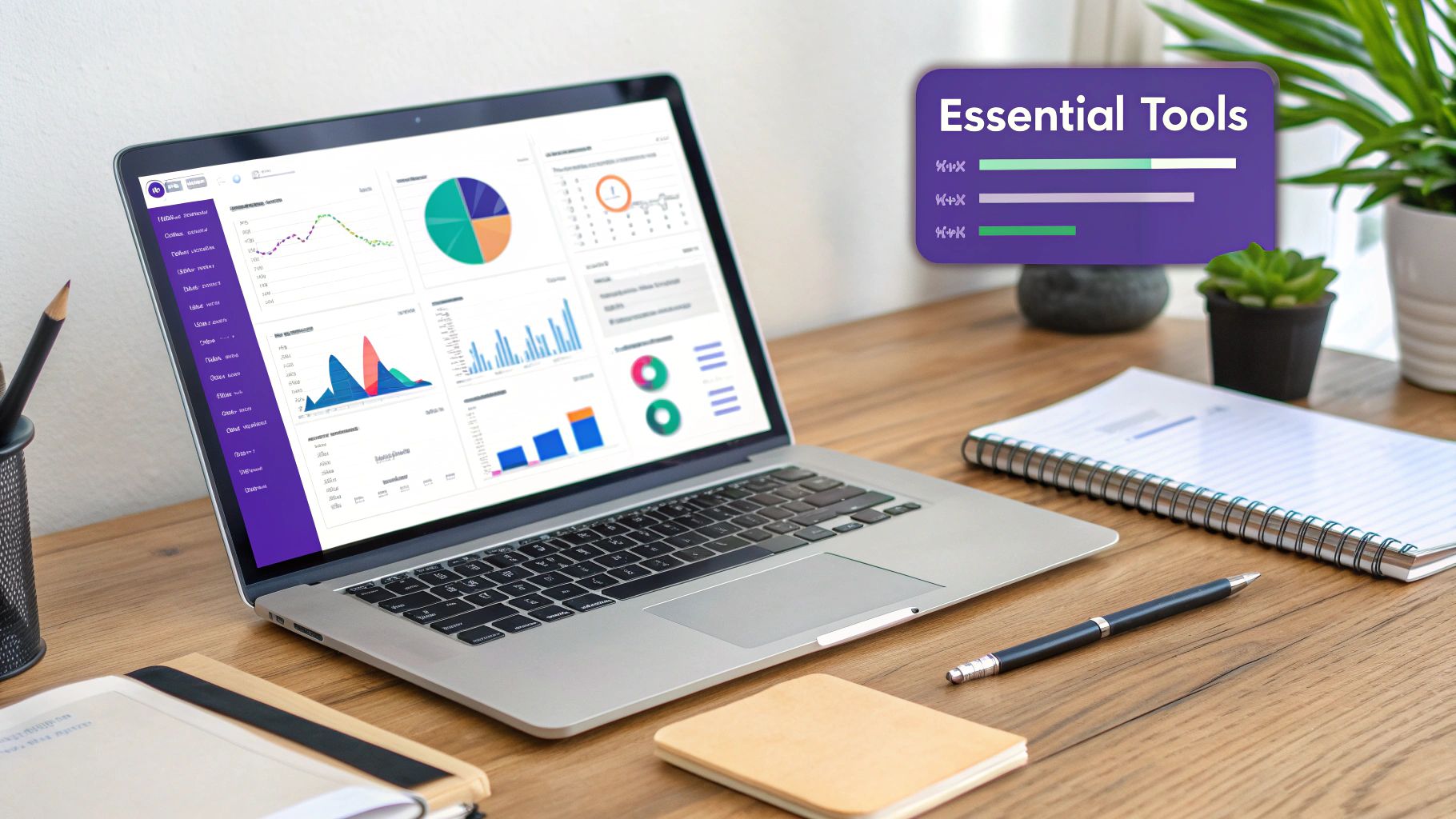
As you can see, you can mix and match rules to create super-specific visitor segments, all without touching a single line of code.
Your First Personalized Content Block
Let's walk through a quick, practical example. Say you want to offer a free guide to new visitors to grow your email list. With a tool like Divi Areas Pro, here's how you'd do it:
- Create Your Content: First up, you design the section you want to show. In this case, it might be a small section with a catchy headline, an image of the guide, and an email signup form. You build this just like any other module in Divi.
- Define the Area: Next, you save that section as a Divi Area, which essentially turns it into a reusable content block.
- Set the Trigger and Conditions: Now for the fun part—setting the rules. You could configure it to show up as a popup or a fly-in. The crucial condition here would be setting the "Visitor Status" to "Is a new visitor."
- Publish: With those rules locked in, you hit publish. That's it. Now, only first-time visitors will see your lead magnet, giving them a special offer without bugging your loyal, returning audience.
This is just scratching the surface of what you can do. A plugin like this is a fantastic way to manage and deliver all sorts of conditional content. To really get a feel for how this plugs into the Divi framework, you should check out our deep dive into Divi dynamic content. The possibilities are pretty much endless, from simple welcome messages to complex, multi-layered marketing campaigns.
Alright, once you’ve got the basics down, this is where the fun really begins. We're about to move past the simple stuff and dive into some genuinely creative ways to use content personalization.
This isn't just about swapping out a headline here and there. It's about building a smarter, more intuitive journey for your visitors—one that feels like it knows exactly what they need, right when they need it. Let's look at some practical ideas you can put into action today.
Location-Based Promotions
One of the easiest yet most powerful tricks in the book is using a visitor's location.
Imagine you own a local shop in Austin, Texas. Instead of showing the same generic banner to everyone on the planet, you can create one that only appears for people browsing from the Austin area.
Example: A simple banner pops up saying, "Hey Austin! Get 15% off your in-store purchase this week." This message is hyper-relevant to locals and can be a huge driver for actual foot traffic.
Just like that, your website goes from being a generic online brochure to a targeted, local marketing machine.
Tailoring Offers for New vs. Returning Users
Let's be honest, the way you talk to a first-time visitor should be completely different from how you greet a loyal customer. Personalization lets you do just that, making everyone feel seen.
- For New Visitors: Roll out the welcome mat with a one-time offer. A little fly-in that says, "Welcome! Here’s 10% off your first order" is often all it takes to turn a curious browser into a paying customer.
- For Returning Users: Acknowledge that you know them. A friendly, "Welcome back! Here's what's new since you've been gone" makes people feel valued and nudges them to check out your latest products or posts. It's a small touch that builds loyalty.
Device-Specific Calls to Action
Finally, you can get super practical by changing your calls-to-action based on the device someone is using. Think about it: asking an Android user to "Download on the App Store" is just clumsy and creates a dead end.
Instead, you can set a simple rule to show an App Store button only to iPhone and iPad users. For everyone else? They see a button for the Google Play Store. This tiny tweak removes a point of friction and makes for a much smoother, more thoughtful user experience.
Of course, here is the rewritten section, crafted to sound completely human-written and natural, following the provided style guide and examples.
Common Questions About Content Personalization
As you start wrapping your head around content personalization, a few questions almost always pop up. Let's tackle them head-on, because clearing up these common concerns can make the whole idea feel a lot less intimidating.
One of the biggest worries I hear is whether personalization will mess up a site's SEO. The short answer? Nope, not if you do it right. Search engine bots typically crawl a default version of your site since they don't have cookies or a user history to trigger any rules. In fact, by boosting user engagement—think longer time on site and lower bounce rates—personalization can actually send some very positive signals to search engines, giving your SEO a nice, indirect lift.
Is It Only for Big Companies?
Another myth is that personalization is a game only for e-commerce giants like Amazon. That might have been true years ago, but not anymore. Thanks to more accessible tools, businesses of all sizes can get in on the action.
A local plumber can show different service highlights to visitors from neighboring towns. A blogger can offer a simple ebook to new readers and a premium course to their loyal subscribers. A nonprofit can even tailor its donation appeals based on past interactions. You don't need a mountain of data to get started; simple signals like a visitor's location or whether they're a first-time guest are surprisingly powerful.
This is exactly why adoption is skyrocketing. One recent survey found that 89% of marketing leaders now see personalization as critical. But here's the kicker: while 85% of companies think they're delivering personalized experiences, only 60% of consumers agree. That’s a huge gap waiting to be filled.
With the personalization software market expected to hit $11.6 billion by 2026, it's clear this isn't just a trend—it's a core strategy for growth. You can dive deeper into these personalization statistics to get the full picture.
You can create high-impact personalized experiences with less data than you think. Begin with simple rules, measure the results, and build more complex strategies as you learn more about your audience.
Ready to bring powerful, code-free personalization to your Divi website? With Divimode, you can create targeted popups, dynamic content, and unique user experiences that boost engagement and drive conversions. https://divimode.com
